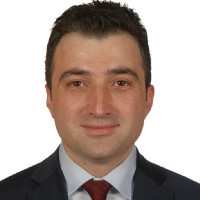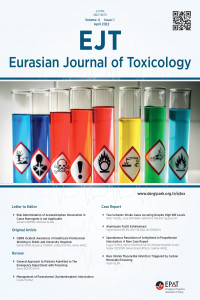Issue Editorial Board

 0000-0003-2005-6100
0000-0003-2005-6100

 0000-0003-1061-5327
0000-0003-1061-5327
 0000-0002-0793-3693
0000-0002-0793-3693

 0000-0002-6549-4246
0000-0002-6549-4246

Aim & Scope
Official Publication of the Emergency Medicine Physicians Association of Turkey (EPAT).
Eurasian Journal of Toxicology (Eurasian J Tox) is an independent, unbiased, double-blind peer reviewed scientific publication organ of the Emergency Medicine Physicians Association of Turkey (EPAT). The journal is published there times a year (triannually) in April, August and December and only published online.
The journal aims to publish scientifically high quality articles, reviews, case reports, letters to the editor, editorial comments, scientific letters and education articles, which can contribute to the medical literature in the field of clinical toxicology and drug research. The journal is relevant to all researchers, residents, assistants, doctors and other health professionals who carry out scientific studies in the field of clinical toxicology.
Original articles, editorial comments, review articles, case reports, letters to editor, scientific letters, clinical imaging and education articles, that can contribute to readers, drug researches and toxicology are welcomed.
Eurasian Journal of Toxicology is an open access journal. Processing, publication, and membership are free of charge with Eurasian Journal of Toxicology. All costs of the journal are covered by EPAT in order to encourage scientific contribution and good publication. No fees are requested from the authors at any point throughout the evaluation and publication process.The journal’s target audience includes all researchers, residents, assistants, doctors and other health professionals who carry out scientific studies in the field of clinical toxicology.
Editorial and publication processes of the journal are shaped in accordance with the guidelines of the international organizations such as the International Council of Medical Journal Editors (ICMJE), the World Association of Medical Editors (WAME), the Council of Science Editors (CSE), the Committee on Publication Ethics (COPE), the European Association of Science Editors (EASE). The journal is in conformity with Principles of Transparency and Best Practice in Scholarly Publishing (doaj.org/bestpractice).
All manuscripts must be submitted via the online submission system which is available through the journal’s web page at https://dergipark.org.tr/ejtox
Statements or opinions expressed in the manuscripts published in the journal reflect the views of the author(s) and not the opinions of the Eurasian Journal of Toxicology, the editors, the reviewers, the editorial board, the advisory board. The editors, the reviewers, the editorial board, the advisory board disclaim any responsibility or liability for such materials.
Emergency Medicine Physicians’ Association of Turkey holds the international copyright of all content published in the journal
Author Guidelines
Eurasian Journal of Toxicology (Eurasian J Tox), as a double-blind peer reviewed journal published by the Emergency Medicine Physicians’ Association of Turkey, to publish original articles, editorial comments, review articles, case reports, letters to editor, scientific letters, clinical imaging and education articles, that can contribute to the medical literature in the field of clinical toxicology and drug reasearches.
Editorial and publication processes of the journal are shaped in accordance with the guidelines of the international organizations such as the the World Association of Medical Editors (WAME), the International Council of Medical Journal Editors (ICMJE), the Council of Science Editors (CSE), the Committee on Publication Ethics (COPE), and the European Association of Science Editors (EASE). The journal follows the Principles of Transparency and Best Practice in Scholarly Publishing (doaj.org/bestpractice).
An approval of research protocols by Ethics Committee in accordance with international agreements (World Medical Association Declaration of Helsinki “Ethical Principles for Medical Research Involving Human Subjects”, amended in October 2013, www.wma.net ) is required for experimental, clinical and drug studies and some case reports. If required, ethics committee reports or an equivalent official document may be requested from the authors. For manuscripts concerning experimental research on humans, a statement should be included that shows informed consent of patients and volunteers was obtained following a detailed explanation of the procedures that they may undergo. For studies carried out on animals, the measures taken to prevent pain and suffering of the animals should be stated clearly. Information on patient consent, name of the ethics committee and the ethics committee approval number should also be stated in the materials and methods section of the manuscript. It is the authors’ responsibility to carefully protect the patients’ anonymity. For photographs that may reveal the identity of the patients, releases signed by the patient or their legal representative should be enclosed.
Journal’s publication language is English. In addition, the title, abstract and keywords of all published articles must be available in English. It is mandatory to send title, abstract and keywords in both languages together with the manuscript.
Manuscript Format
Manuscripts should be created using Microsoft Word and be double-spaced with 2.5-cm margins on all sides. The recommended font is Times New Roman and the recommended font size is 12 point. References should be arranged according to the citation order in the manuscript.
Manuscript Preparation
The manuscripts should be prepared in accordance with ICMJE-Recommendations for the Conduct, Reporting, Editing and Publication of Scholarly Work in Medical Journals (updated in December 2017 - http://www.icmje.org/icmje-recommendations.pdf). Authors are required to prepare manuscripts in accordance with CONSORT guidelines for randomized research studies, STROBE guidelines for observational original research studies, STARD guidelines for studies on diagnostic accuracy, PRISMA guidelines for systematic reviews and meta-analysis, ARRIVE guidelines for experimental animal studies and TREND guidelines for non-randomized public behavior.
Manuscripts can be submitted online via http://dergipark.gov.tr/ejtox
Authors are required to submit the;
Copyright Transfer Form which states transfer of the copyright about the submitted manuscript to Eurasian Journal of Toxicology.
Author Contributions Form
Cover Letter: To the editor in which you detail matters you wish the editors to consider.
Title Page: A separate title page should be submitted with all submissions, and this page should include;
ü The full title of the manuscript
ü Name(s), affiliations and major degree(s) of the author(s)
ü Grant information and detailed information on the other sources of support,
ü The name, affiliation, address, work telephone, fax number, mobile phone number and e-mail address of the corresponding author,
ü Acknowledgement of the individuals who contributed to the preparation of the manuscript, but do not fulfil the authorship criteria.
ü Conflict of interest statement. In the case of ‘no conflicts of interest’, that statement should be in form of: “All authors declare that they have no conflicts of interest regarding this manuscript.”
Abstract: The abstract of Original Articles should be structured with subheadings (Objective, Materials and Methods, Results and Conclusion). It is mandatory to send an abstract in Turkish and English languages together with the manuscript.
Keywords: The submission must be accompanied by a minimum of three and a maximum of five keywords for subject indexing at the end of the abstract (they must be terms from the medical subject headings - MeSH - list of the Index Medicus: PubMed MeSH Browser). The keywords should be listed in full without abbreviations.
Manuscript Types
Original Articles: The entire manuscript for a full-length article, including references and tables, should be no more than 5000 words. The main text of original articles should be structured with Introduction, Materials and Methods, Results, Discussion, Conclusion subheadings. Limit for references is 40.
Case Reports: The text should include Abstract, Introduction, Case Report, Discussion, Conclusion subheadings. The entire manuscript for a full-length article, including references and table, should be no more than 1500 words. Limit for references is 20 and only one table or figure can be added.
Review Articles: The authors may be invited by the journal. For uninvited articles authors must contact the editor. The entire manuscript should be no more than 5000 words and the abstract should be a maximum of 400 words. Limit for references is 50.
Letter to the Editor: Abstract, Keywords, Tables, Figures, Images and other media are not included. The text should be unstructured. The manuscript that is being commented on must be properly cited within the manuscript. The entire manuscript should be no more than 500 words. Limit for references is five and only one table or figure can be added.
References
While citing publications, preference should be given to the latest, most up to date publications. If an ahead of print publication is being cited the DOI number should be provided. Authors are responsible for the accuracy of references. Journal titles should be abbreviated in accordance with the journal abbreviations in Index Medicus/ Medline/PubMed (for journal abbreviations consult the List of Journals indexed for MEDLINE, published annually by NLM). When there are 6 or fewer authors, all authors should be listed. If there are 7 or more authors the first 6 authors should be listed followed by “et al”. The reference styles for different types of publications are presented in the following examples:
Journal article: Lewin MR, Stein J, Wang R, Lee MM, Kernberg M, Boukhman M, et al. Humming is as effective as Valsalva’s maneuver and Trendelenburg’s position for ultrasonographic visualization of the jugular venous system and common femoral veins. Ann Emerg Med. 2007; 50: 73-7.
Book Section: Sherry S. Detection of thrombi. In: Strauss HE, Pitt B, James AE, editors. Cardiovascular Medicine. St Louis: Mosby; 1974.p.273-85.
Books with Single Author: Cohn PF. Silent myocardial ischemia and infarction. 3rd ed. New York: Marcel Dekker; 1993.
Editor(s) as author: Norman IJ, Redfern SJ, editors. Mental health care for elderly people. New York: Churchill Livingstone; 1996.
Conference Proceedings: Bengisson S. Sothemin BG. Enforcement of data protection, privacy and security in medical informatics. In: Lun KC, Degoulet P, Piemme TE, Rienhoff O, editors. MEDINFO 92. Proceedings of the 7th World Congress on Medical Informatics; 1992 Sept 6-10; Geneva, Switzerland. Amsterdam: North-Holland; 1992.p.1561-5.
Scientific or Technical Report: Smith P. Golladay K. Payment for durable medical equipment billed during skilled nursing facility stays. Final report. Dallas (TX) Dept. of Health and Human Services (US). Office of Evaluation and Inspections: 1994 Oct. Report No: HHSIGOE 169200860.
Thesis: Kaplan SI. Post-hospital home health care: the elderly access and utilization (dissertation). St. Louis (MO): Washington Univ. 1995.
Epub ahead of print Articles: Logan, BK, Mohr ALA, Friscia M, Krotulski AJ, Papsun DM, Kacinko SL, et al. (2017) Reports of adverse events associated with use of novel psychoactive substances, 2013–2016: a review. Journal of Analytical Toxicology. doi: 10.1093/jat/bkx031
Manuscripts published in electronic format: Rupprecht C. Ready for more-than-human? Urban residents’ willingness to coexist with animals and plants. Version: 1. SocArXiv [Preprint]. [posted 2016 Jul 13; revised 2016 Dec 07; cited 2017 Feb 15]: [22 p.]. Available from:https://osf.io/preprints/socarxiv/hbcmz/.
Tables
Tables should be included in the main document, presented after the reference list and they should be numbered consecutively in the order they are referred to within the main text. A descriptive title must be placed above the tables. Abbreviations used in the tables should be defined below the tables by footnotes (even if they are defined within the main text). Tables should be created using the “insert table” command of the word software and they should be arranged clearly to provide an easy reading. Data presented in the tables should not be a repetition of the data presented within the main text but should be supporting the main text.
Figures and Figure Legends
Figures, graphics and photographs should be submitted as separate files (in TIFF or JPEG format). The files should not be embedded in a word document or the main document. When there are figure subunits, the subunits should not be merged to form a single image. Thick and thin arrows, arrowheads, stars, asterisks and similar marks can be used on the images to support figure legends. Like the rest of the submission, the figures too should be blind. Any information within the images that may indicate an individual or institution should be blinded. The minimum resolution of each submitted figure should be 300 DPI. To prevent delays in the evaluation process all submitted figures should be clear in resolution and large in size (minimum dimensions 100 x 100 mm). Figure legends should be listed at the end of the main document.
Acronyms and Abbreviations
All acronyms and abbreviations used in the manuscript should be defined at first use in the main text. The abbreviation should be provided in parenthesis following the definition. Acronyms and abbreviations should not be used in the abstract.
Submission Checklist
You can use this list to make a final check of your submission before you send it to the journal for review. Ensure that the following items are present:
· One author has been designated as the corresponding author with contact details including name, affiliation, address, work telephone, fax number, mobile phone number and e-mail address.
· All necessary files have been uploaded:
ü Cover Letter
ü Title Page
ü Manuscript
ü Figures
ü Supplemental files (where applicable)
ü Author Contributions Form
ü Copyright Transfer Form
· Ensure all figure and table citations in the text match the files provided
· Manuscript has been spell checked and grammar checked
· All references mentioned in the Reference List are cited in the text, and vice versa
· Permission has been obtained for use of copyrighted material from other sources (including the Internet)
· A conflict of interests statement is provided in the Title Page even if the authors have no competing interests to declar
· Journal aim and scope have been reviewed
For further information,
Acil Tıp Uzmanları Derneği
Address: Yukarı Ayrancı Güleryüz Sok. No: 26/19 06550 Çankaya, Ankara, Turkey
Phone: +90 312 426 12 14
Fax:+90 312 426 12 44
E-mail:info@ejtoxicology.com
Ethical Principles and Publication Policy
Editorial and publication processes of the journal are shaped in accordance with the guidelines of the international organizations such as the International Council of Medical Journal Editors (ICMJE), the World Association of Medical Editors (WAME), the Council of Science Editors (CSE), the Committee on Publication Ethics (COPE), the European Association of Science Editors (EASE). The journal is in conformity with Principles of Transparency and Best Practice in Scholarly Publishing (doaj.org/bestpractice).
Price Policy
Submission of articles to the journal and evaluation process is completely free.
Dergiye makale gönderimi ve değerlendirme süreci tamamen ücretsizdir.

